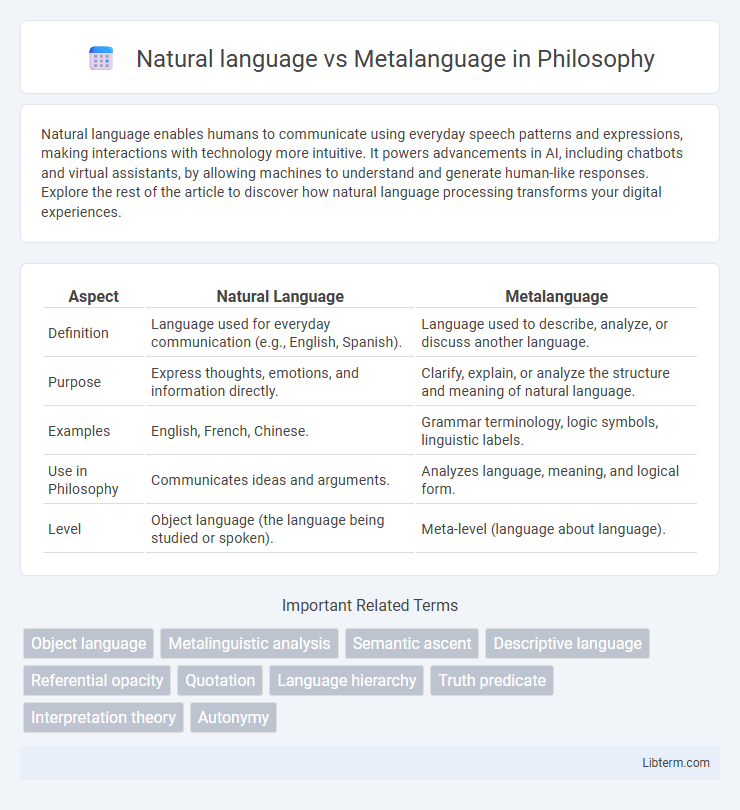Natural language enables humans to communicate using everyday speech patterns and expressions, making interactions with technology more intuitive. It powers advancements in AI, including chatbots and virtual assistants, by allowing machines to understand and generate human-like responses. Explore the rest of the article to discover how natural language processing transforms your digital experiences.
Table of Comparison
| Aspect | Natural Language | Metalanguage |
|---|---|---|
| Definition | Language used for everyday communication (e.g., English, Spanish). | Language used to describe, analyze, or discuss another language. |
| Purpose | Express thoughts, emotions, and information directly. | Clarify, explain, or analyze the structure and meaning of natural language. |
| Examples | English, French, Chinese. | Grammar terminology, logic symbols, linguistic labels. |
| Use in Philosophy | Communicates ideas and arguments. | Analyzes language, meaning, and logical form. |
| Level | Object language (the language being studied or spoken). | Meta-level (language about language). |
Introduction to Natural Language and Metalanguage
Natural language refers to the everyday spoken and written languages humans use for communication, such as English, Spanish, or Chinese, characterized by its complexity, ambiguity, and evolving nature. Metalanguage is a language or set of terms used to describe, analyze, or discuss another language, providing tools and frameworks for understanding linguistic structures, grammar, and semantics. In linguistics and computer science, metalanguage plays a crucial role in formalizing and clarifying the rules and elements of natural language, enabling precise language processing and language learning models.
Defining Natural Language: Characteristics and Examples
Natural language refers to the organic, naturally developed languages used by humans for everyday communication, characterized by ambiguity, variability, and context-dependence. Examples include English, Mandarin, and Spanish, all of which feature evolving vocabulary, idiomatic expressions, and syntax that adapt over time. Natural languages contrast with formal or metalanguages, which are explicitly designed for specific linguistic or computational purposes with rigid structures and defined rules.
Understanding Metalanguage: Purpose and Usage
Metalanguage serves as a specialized linguistic tool designed to describe, analyze, and interpret natural language structures and meanings. It provides a framework for discussing grammar, syntax, and semantics, enabling clearer communication about language itself. Understanding metalanguage enhances language learning, linguistic research, and effective communication by offering precise terminology to examine language components.
Key Differences Between Natural Language and Metalanguage
Natural language consists of everyday spoken or written communication used by humans, rich in ambiguity and contextual meaning, while metalanguage refers to a language used to describe, analyze, or discuss another language, often with precise, formal symbols and rules. Natural language evolves organically and varies across cultures, whereas metalanguage is structured and intentionally designed for linguistic, logical, or computational analysis. Key differences include their purpose--natural language facilitates general communication, whereas metalanguage serves to explain or manipulate language itself--and their levels of abstraction and clarity.
The Role of Metalanguage in Linguistics
Metalanguage serves as a critical tool in linguistics by providing a structured system of terms and symbols used to describe, analyze, and interpret natural language. It enables linguists to objectively discuss syntactic, semantic, and phonological features without ambiguity, facilitating precise communication about language phenomena. The metalanguage thus underpins linguistic theory development, language education, and computational language processing by standardizing terminology and conceptual frameworks.
Functions of Natural Language in Communication
Natural language functions as the primary tool for conveying thoughts, emotions, and information in everyday communication, enabling effective interaction through words and sentences understood by people. It facilitates expression, comprehension, and social connection by allowing speakers to share experiences and intentions intuitively. Unlike metalanguage, which describes or analyzes language itself, natural language operates as the medium for real-time transactional and relational communication.
Applications of Metalanguage in Language Analysis
Metalanguage serves as a critical tool in linguistics, enabling detailed analysis and description of natural language structures through specialized vocabulary and symbolic representations. Applications of metalanguage include syntax parsing, semantic annotation, and the development of formal grammars used in computational linguistics and natural language processing (NLP). These applications facilitate language learning, machine translation, and linguistic research by providing a framework to systematically examine and manipulate linguistic elements.
Advantages and Limitations of Natural Language
Natural language excels in expressiveness and accessibility, allowing users to communicate complex ideas intuitively without requiring specialized training. Its limitations include ambiguity, imprecision, and context dependence, which often hinder clarity in technical or formal settings. Despite these drawbacks, natural language remains essential for everyday communication and serves as the foundation upon which metalanguages are constructed.
How Metalanguage Enhances Language Learning
Metalanguage provides the necessary framework to analyze and describe natural language structures, enabling learners to understand grammar, syntax, and semantics more clearly. By using metalanguage, students can identify language patterns and rules, which enhances their ability to self-correct and develop advanced linguistic skills. This metalinguistic awareness supports deeper cognitive processing, leading to improved language acquisition and communication proficiency.
Conclusion: Bridging Natural Language and Metalanguage
Natural language facilitates everyday communication with its rich, context-dependent expressions, while metalanguage provides a systematic framework for describing and analyzing linguistic structures. Bridging natural language and metalanguage enhances understanding by allowing precise interpretation of meaning and facilitating language learning, translation, and computational linguistics. Integrating these two approaches fosters improved language processing technologies and deeper linguistic insights.
Natural language Infographic

 libterm.com
libterm.com